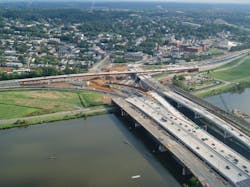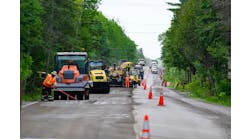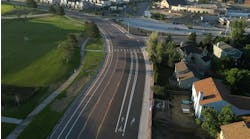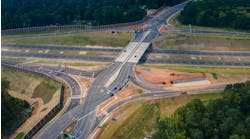PROJECT: 11th Street Bridges Design-Build
In a matter of hours, playoff baseball was about to make a return to Washington, D.C., for the first time in decades. Less then a mile away, they were slowly dismantling a losing platform and celebrating every minute of it.
Two welders worked vigorously, poking fire through what was left of a steel beam on the old 11th Street Bridges in late September. In a matter of minutes, the chunk was lifted away and out of sight. The operation was as smooth as the best double play baseball could offer, and the overall project is nothing short of a game-changer, providing once and for all a connection between D.C.’s I-295 and the Southeast/Southwest Freeway (I-395/I-695).
The 11th Street Bridges Design-Build project is No. 1 on the Roads & Bridges 2012 Top 10 Bridges list; a triple crown winner if the categories consisted of traffic congestion relief, innovative delivery and environmental stewardship.
The jobsite is the backbone of the Anacostia Waterfront Initiative, a 30-year, $10 billion multifaceted program to restore and revitalize the Anacostia River and its waterfront. The Navy Yard is just a stone’s throw away, and the relocation of the Department of Homeland Security is about to put a charge into a development boom in the Anacostia neighborhood.
Keep them separate
Built in the mid-20th century, the old 11th Street Bridges had long exceeded their service lives. Listed as structurally deficient and unable to make any kind of transition between I-295 and I-395/I-695 and local routes, the pair of spans had been tagged to be reconstructed for quite some time, but the options, both structural and financial, were complicated. A project of this magnitude was estimated to cost $460 million, but only $260 million was available. Due to the budget tightening, some believed reconstructing the existing bridges would factor into the right decision. However, dense urban surroundings added to the degree of difficulty.
Lead designers HNTB and URS and the District Department of Transportation (DDOT) engaged in a design-build-to-budget procurement model. DDOT established a fixed price and delivery deadline, and it was up to the contractor to work within the footprint. It came down to five proposals, with DDOT going with the plan worked up by the Skanska/Facchina joint venture. The winning approach called for the new construction of three 1,000-ft-long bridges—two handling the interstate system and one serving the local community. Most of the work would be handled offline while traffic continued on the existing route, and according to Peter McDonough, associate vice president, SE Division, and a construction services manager for HNTB Corp., “80% of the traffic movements were 60% of the original budget, so that is how the contractor was selected.
“We allowed the contractor to approach it from his best skills set,” he told Roads & Bridges. “By actually building the three new river crossings it was easier to get that proper alignment in there.”
Skanska/Facchina also had to be careful with its handling of the Anacostia River, which had been abused for generations. Fish migration also came into play. During a four-month window between March and July, construction is typically restricted in the river to accommodate the activity. Skanska/Facchina decided to move forward without constructing cofferdams, and through the use of innovative precast, post-tensioned, 6-ft-diam. concrete piling they were able to create minimal disturbance to the riverbed by driving the piles through a barge template. The piles were driven approximately 50 ft down to bedrock. Each pier consisted of five columns.
“Because they did that, the moratorium was waived,” said McDonough.
The joint venture also benefitted from the DDOT going against what it normally did in an effort to fit the project in the tight budget and timeline. DDOT does not install stay-in-place forms to help build concrete bridge decks. The practice is done in Virginia, and Skanska/Facchina approached the agency about trying it in Washington, D.C. The move eliminated the need for crews to come in after construction and remove forms, resulting in a cost savings of $1 million. After pier construction—each bridge has four in the water—the high-strength, deep-corrugated galvanized steel units were installed on top of the girders. Crews then placed the rebar before laying down the bridge deck. The first major interstate movement—I-295 to inbound I-395/695—was open to traffic on July 30, and the achievement was a monumental one. Any further delays would have forced the DDOT to place weight restrictions on the original bridges.
DDOT also allowed the contractor to adapt Virginia’s technique when it comes to installing drainage systems, which is geared more toward the interstate system instead of one that is typically used on DDOT’s urban street system. With the urban system, a manhole must be placed at every inlet. The requirement is not as extensive on the interstate system.
With Skanska/Facchina pulling off one innovative move after another, the DDOT agreed to take on utility responsibilities, which were quite extensive due to the fact that the project was directly on top of approximately 200 years of older, now-buried development.
Time cannot be pulled, but it can be chopped. DDOT and Skanska/Facchina worked with the community on a six-month detour that knocked off four months of the work schedule. Access to a bridge that went over the CSX railroad was completely shut off to traffic, reducing a two-phased plan down to one. The partnership with the CSX railroad is expected to pay off in the future as well. The 11th Street Bridges project was in full swing when the CSX was going through initial planning to upgrade an existing tunnel so it could have double-stack capabilities. To avoid any rework long after project completion, DDOT and Skanska/Facchina made sure the two sets of plans coordinated with each other. For example, instead of installing an MSE wall on 11th Street near M Street, crews constructed a two-span bridge to accommodate a runaround track.
Bridge with a view
The new local bridge that will cross the Anacostia River will have multimodal capabilities. A 15-ft-wide bike/pedestrian path takes up part of the span, and another section is devoted to future streetcar use. Crews have constructed bump-outs to accommodate future track. The streetcar is making a comeback in Washington, D.C. The city is currently executing a 37-mile project that will mark the return of the transportation mode.
“The district is very high on being able to build choices for commuters and residents so that the car is not the only mode of transportation that we look at,” Nick Nicholson of the DDOT told Roads & Bridges. “Those have been maintained throughout construction as well.”
The old outbound bridge will not be entirely removed. According to McDonough, two channel piers are going to be repurposed and will be connected to the new local bridge and serve as an observation deck.
“It gives you a view of Anacostia, the Frederick Douglas Bridge, the historic Navy Yard and the landscape of the city,” said McDounough.
At press time, phase one was about 85% complete, and all three of the river bridges were finished. Substantial completion will be achieved by the end of this year. Phase two of the local bridge is currently under construction and is set to be finished in December. The old outbound bridge was about 90% demolished and the inbound bridge was currently under demolition. The reconstruction of 11th Street between the north river embankment and M Street also was taking place. When complete it will handle two-way traffic in each direction. R&B



